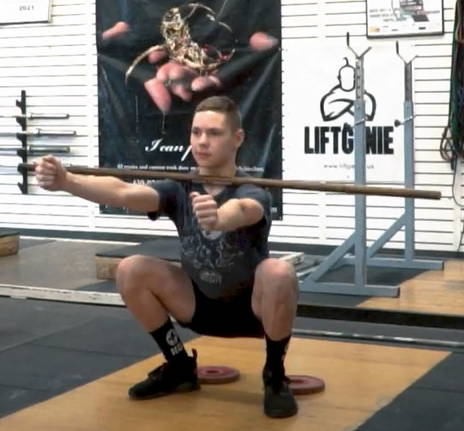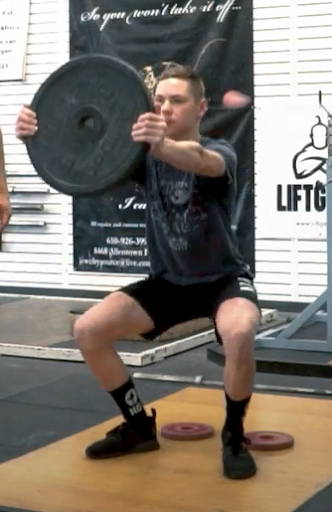How to Squat ... Deeper
When we are training all of our athletes here at Garage Strength, we like to get them to squat deep. There are a couple of reasons why. And let’s start with that internet favorite clickbait question: Is it actually important to squat with a full range of motion? And to clarify, when we say a full range of motion, we mean ass to grass. We want to see the glutes draped over the calves.

Now we don’t always squat ass to grass, but we like our athletes to have that capability. For starters, we want to see the full range of motion to understand the athlete’s mobility. Where are they tight? Where are they loose? Where can they actually work through that full range of motion? On top of that, we train a lot of weightlifting movements and there is a large carryover from a high bar back squat that is a full range of motion into weightlifting.
The next key factor is that we want to train dynamic trunk control for all our athletes. So if we are training for sports performance, say wrestling or football, athletes will be in deep ranges of motion. These deep positions in sports benefit from training dynamic trunk control from that full depth movement which will enhance their overall performance.
All of these factors are important to consider when doing the full range of motion movement. We want to enhance sports performance, mobility, and also when training specific weightlifting movements, technical coordination movements, we will see a direct carryover from the high bar back squat into the actual technical coordination.
This is the progression we use for the high bar back squat.
1. Air Squat (Keep It Simple)
When we start to teach the full range of motion squat we need to have the progressions established ahead of time.
The first step we will take when a young athlete or novice athlete comes into our door, like a fourth or fifth-grader, and we want to see how they move is to take notice of how they set their foot width. We have them place one foot perpendicular to the other foot to establish a foot-width apart. The stance needs to be a little bit wider than foot-width apart.
Then we have the athlete put their arms out. We teach the athletes to think about an invisible string pulling the knees forward and the hips backward at the exact same time. The knees track forward over the toes and the hips shift back as the athlete sits into the hole. Five reps in this manner give a great snapshot for evaluation.
If we see somebody who tends to be a little stiffer in the ankles, their heels start to pop, hips don’t drop back, and their knees don’t track forward, we will have them put their heels up on plates for a little bit of a cheat. It will increase the range of motion and make the movement a little easier by elevating the heel.
Air squats or heel air squats are a great place to start. In that manner, it keeps things as simple as possible. Don’t walk athletes through the whole eccentric portion of the squat. Just use simple cues like, “Knees forward,” or “Butt back”.
2. Dowel Rod Zombie Squat
This can be done with a dowel rod, a PVC pipe, or an incredibly light weightlifting bar, preferably a bar no more than five kilos.
We want to see the knees tracking forward, the hips coming back, with an upright posture. We don’t want athletes to put a lot of stress on their hips or lower back from a super-wide stance. We want the athletes to be mobile in their ankles, knees, lower back, and thoracic spine.

We will cue the athlete with the knees forward, hips back while focusing on the upright posture as much as possible. Again, the plates can be used to elevate the heels if needed. Regardless of standing on the plates or not, holding the upright posture is the focus.
The zombie squat with the dowel rod forces the athlete to be really aware of their posture so they are not leaning all over the plate.
3. Driver Squat
We will have the athlete hold a plate out in front of the body with the arms extended. The plate resembles a steering wheel. This exercise is really good for athletes who are extremely tight in the lower back and struggle to get deep. It helps teach the full range of motion and can be used as a mobility drill throughout the training session.

4. Dumbbell Goblet Squat
The goblet squat is a great exercise. Goblet squats allow athletes to get a big pump, target mobility in the lower back and can target some quad strength growth without absolutely destroying the body. What the goblet squat does great for athletes learning how to squat with a full range of motion is that the weight helps act as a counterbalance to help athletes get deeper.

We think it is important to have the athlete demonstrate control during the eccentric and come up fast out of the hole. Cues as simple as, “Down slow and up fast,” are perfect.
5. Zombie Squat With A Barbell And Front Squat
These movements are interchangeable; however, if we have athletes who struggle with the front squat front rack, we will do zombie squats first.
Again, we want to stress the posture as the athlete performs this movement. We do not want to see a forward lean. We don’t want the athletes to squat like powerlifters squat in competition--that is fine for the sport of powerlifting but is not optimal for sports performance development.

The upright posture reinforces the body to activate superior dynamic trunk control coordinated into good quad strength for a solid anterior sequence of musculature.
At this point, we can change the grip up and have the athlete go into the front squat position. We need to make sure the whole hand is on the bar. If the whole hand does not grasp the bar, we will need to work on improving the mobility to have a proper front rack. The lats will be nice and solid, the upper back open, and the knees will be pushed forward as descending into the squat.
A key concept during the front squat is keeping the elbows upright. With zombie squats, the arms are straight out but the front squat sometimes causes a person’s elbows to drop differently from the execution of the zombie squat. As a coach, it is important to teach the athlete how to transfer the proceeding movements into the front rack position. This posture helps into the last key piece.
6. Back Squat
We are now in the final piece and reaping the rewards of keeping things simple and progressed through everything from the air squat to the front squat, arriving finally at the back squat.
First, we want to establish a back squat grip. Typically we want to see a thumb length off of the knurling. Tighter athletes may need to go pinky or ring finger on the ring. The bar needs to then be set on the upper back just above the shoulder blades. We want to see a nice contraction with the upper back hugging the spine to create a shelf for where the bar will be placed.
A lot of younger athletes will want a towel to deal with the initial pain of the bar on the skin. DON’T ALLOW IT. It is part of lifting. Deal with the callous and deal with the feeling. Everything will be fine. Using a pad causes the body to lose connection with the barbell.
With that being said, as the athlete comes in and gets loaded, they open up the chest and squeeze through the belly button. Then have them unrack the bar, take two steps back, and establish the proper foot width. Remember and think, pulling the knees forward, pulling the knees back, and keeping the upright posture.
Ideally, athletes will have weightlifting shoes on their feet. The thing is, for most athletes who are just starting to train, they will be in normal, flat sneakers so they have to learn how to squat properly not using the ideal shoe.
Recap
A really important concept with the full range of motion back squat is that it transfers incredibly well to cleans and snatches. The full range of motion back squat also strengthens athletes’ dynamic trunk control, posterior chain, quads, and the entirety of the anterior sequence. It will lead to higher vertical jumps, further broad jumps, and lead to better sprinting mechanics due to enhanced mobility. It will also lead to better agility because of stellar dynamic trunk control.
DANE MILLER
Dane Miller is the owner and founder of Garage Strength Sports Performance. He works with a select handful of clients on building comprehensive programs for fitness and nutrition. Several times a year he leads a workshop for coaches, trainers, and fitness enthusiasts.


